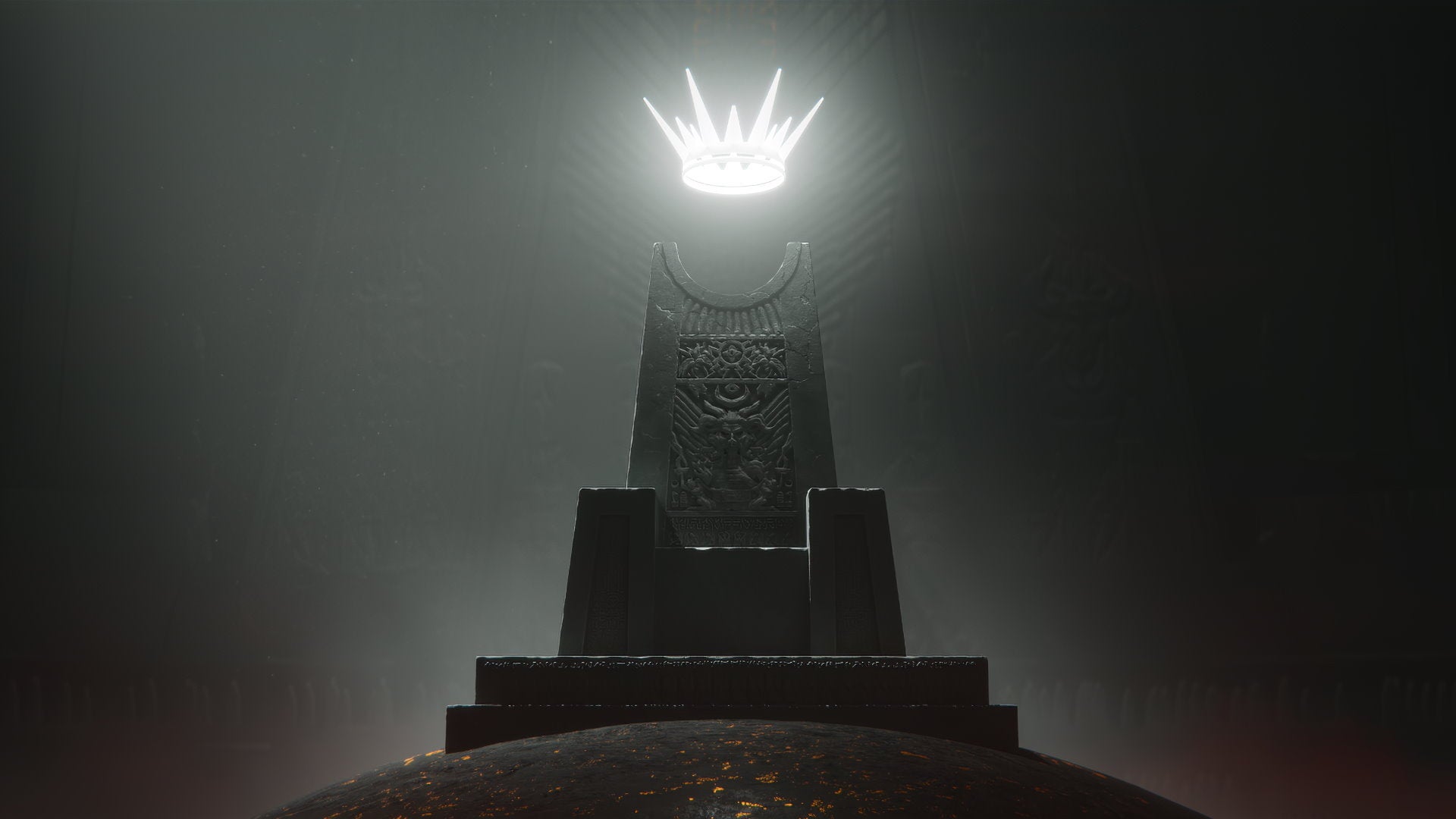Products You May Like
The RPS-beloved turn-based strategy game Solium Infernum is back from the dead. Announced earlier today on stage at EGX London 2022, Armello creators League Of Geeks will be resurrecting and reimagining the game in 2023. Originally released in 2009 by solo dev Vic Davis and his studio Cryptic Comet, Solium Infernum cast you as an Archfiend hoping to stake a claim for Satan’s empty throne. With a strong emphasis on political intrigue and Machiavellian backstabbing over taking things by force, this strategy game from hell was a firm RPS favourite back in the day, spawning an eight-part diary series of the team’s play-by-email multiplayer adventures. Alas, it never quite found the audience it deserved back in the early 2010s, eventually causing Davis to shut up shop completely in 2015 and pursue a career in tabletop.
League Of Geeks are here to change that, though, and after speaking with studio director and co-founder Trent Kusters (both at EGX earlier today and during a hands-off presentation of their pre-alpha demo late last week), it’s clear the team have taken great care in bringing Solium Infernum up to date for modern audiences. It leans into all the same kinds of mind games as Cryptic Comet’s original, and its simultaneous turn structure is still very much intact – just with lusher 3D visuals, and all-new, revamped menu screens. And it looks devilishly good.
First things first, though. If you’re wondering why League Of Geeks are the ones reviving Solium Infernum, it turns out this strategy game has much deeper ties with Armello than you might think.
“It was a huge inspiration for Armello,” Kusters tells me. “Back when we were prototyping Armello on paper, one of the actual versions of the prototype that was the one that made it sort of all come together, was when Ty [Carey], our [studio] director and creative director on this game, actually brought in some elements from Solium Infernum which he’d been playing a bunch of a couple of years earlier. And so it feels like a natural step for us. People always ask us if we’re going to do Armello 2, but this kind of feels like Armello 2, you know?”
Indeed, as our demo begins, the most obvious connection to Armello lies in its animated cards. Most of Solium Infernum plays out in 3D, but its spells, artifacts and legion armies all have their own lavishly drawn cards attached to them that lay out their stats and abilities. Solium also has lots of big, characterful personalities to choose from when picking your player character as well, harking back to Armello’s clutch of hero animals. The two games also share the same composer, Michael Allen, although Solium’s ‘Moog Requiem’ music, as Kusters calls it, is understandably a far cry from the soaring orchestral score Allen made for Armello.
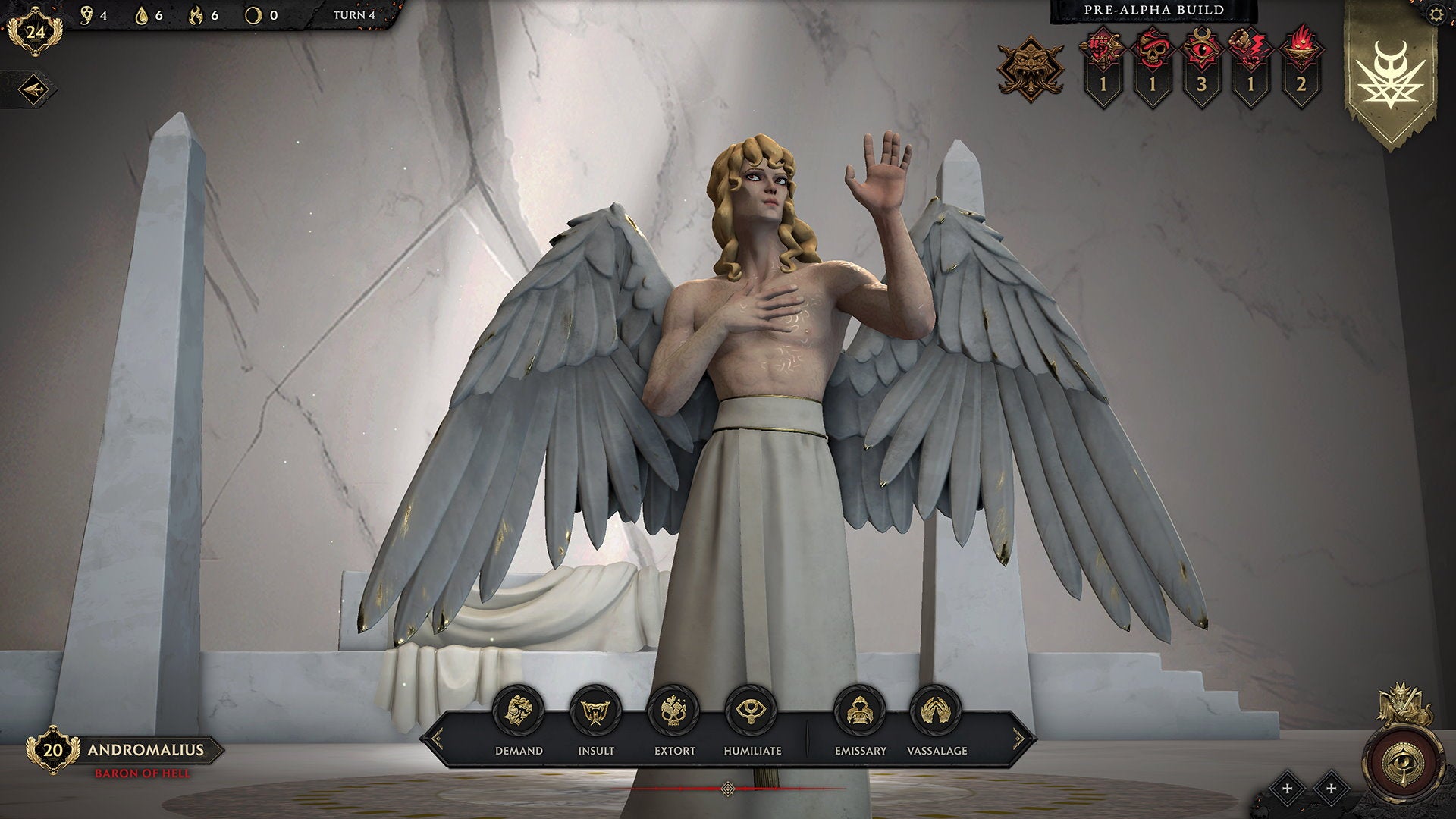
Kusters has chosen to play as Andromalius, the blonde, fallen angel from the reveal trailer, for this particular match, but he’s not alone in this ashen hellpit. Butting up against his territory of golden hexagons are three other AI players all vying for the same goal: to take control of Hell’s capital, Pandemonium, and claim the Infernal Throne for themselves. The map itself loops in all directions, meaning you’re always surrounded at the start of a match. With all fronts open to invasion, you’ll need to pay close attention to all four compass points if you hope to succeed. For the sake of simplicity, though, my demo contained the red lands of the demonic dragon prince Astaroth to the south, the blue plains of the chimeric Belial to the east, and the green realms of the feathery harpy Lilith to the west.
Like the original Solium Infernum, the final game will support up to six players when it comes out next year, but for now we’ve just got a four-player match in progress that’s about 20 turns in –roughly an hour’s worth of play, Kusters tells me. He’s not doing too well at the moment – his prestige level among the other demons is a bit on the low side, and he’s only got one legion army in play. However, over the course of the next five turns, Kusters says he’s going to turn the match around for Andromalius, and all without shedding a single drop of blood to boot.
“We play in that power vacuum where Lucifer has vanished and the Archfiends, the high demon lord rulers of the great houses of Hell, vie for power,” he says. “If you imagine that Civilization is, say, 80% of your time spent on the board, and 20% with the leaders, Solium is the inverse of that. Solium is really into popularity contests. You are working with and against, often underhandedly, all of your opponents and foes in Hell.”
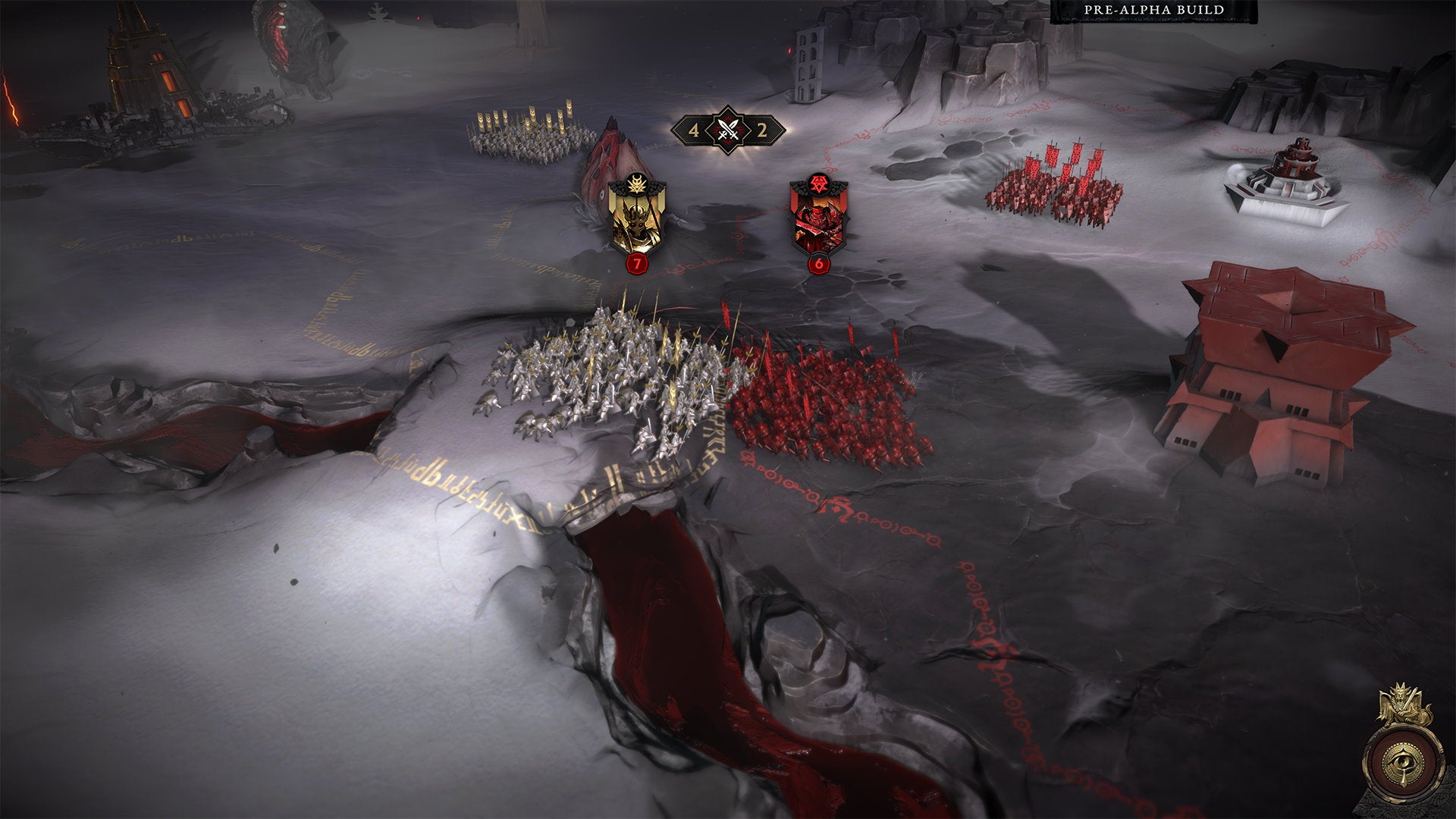
To do this, you’ll be spending a lot of time in the Diplomacy menu. Here you can view each faction’s diplomatic state – who’s warring with who, who’s mates with who and so on. You can also click through to conduct diplomacy with characters individually, leading to characterful portrait menus where you can make specific demands, insult, extort or humiliate them, or even send emissaries, form contracts with them, or enter into a vassalage with them. If you’ve ever played Shiro Games’ Dune: Spice Wars, you’ll feel right at home here.
In our demo, for example, Lilith currently has a vendetta against Astaroth, while Astaroth has one against Andromalius, leaving Belial as the only character not in open conflict with anyone. This is important, as you can’t physically attack other players or invade their claimed hexagons unless you declare a vendetta against them. As such, most matches will likely begin with players making a beeline for their nearest Place Of Power. These are landmarks that help gather the necessary resources you’ll need for your growing armies. Andromalius has laid claim to the Garden Of Infernal Delights, for example, while Astaroth (perhaps somewhat fittingly) has the Great Wheel Of Pain to his name, and the Tree Of Woe. He’s been accumulating quite the little army during the course of the match, boasting three legions to our one.
His territory is also right up against the fringes of Pandemonium at the moment, which is posing a bit of a threat to our chance of winning. But all is not lost. There are two modes of victory in Solium Infernum: you can win through prestige by undertaking the Trial of the Chosen and having the overarching Conclave of Hell declaring you’ve earned the requisite number of tokens, or you can win by usurping the throne by force and holding the city for five turns.
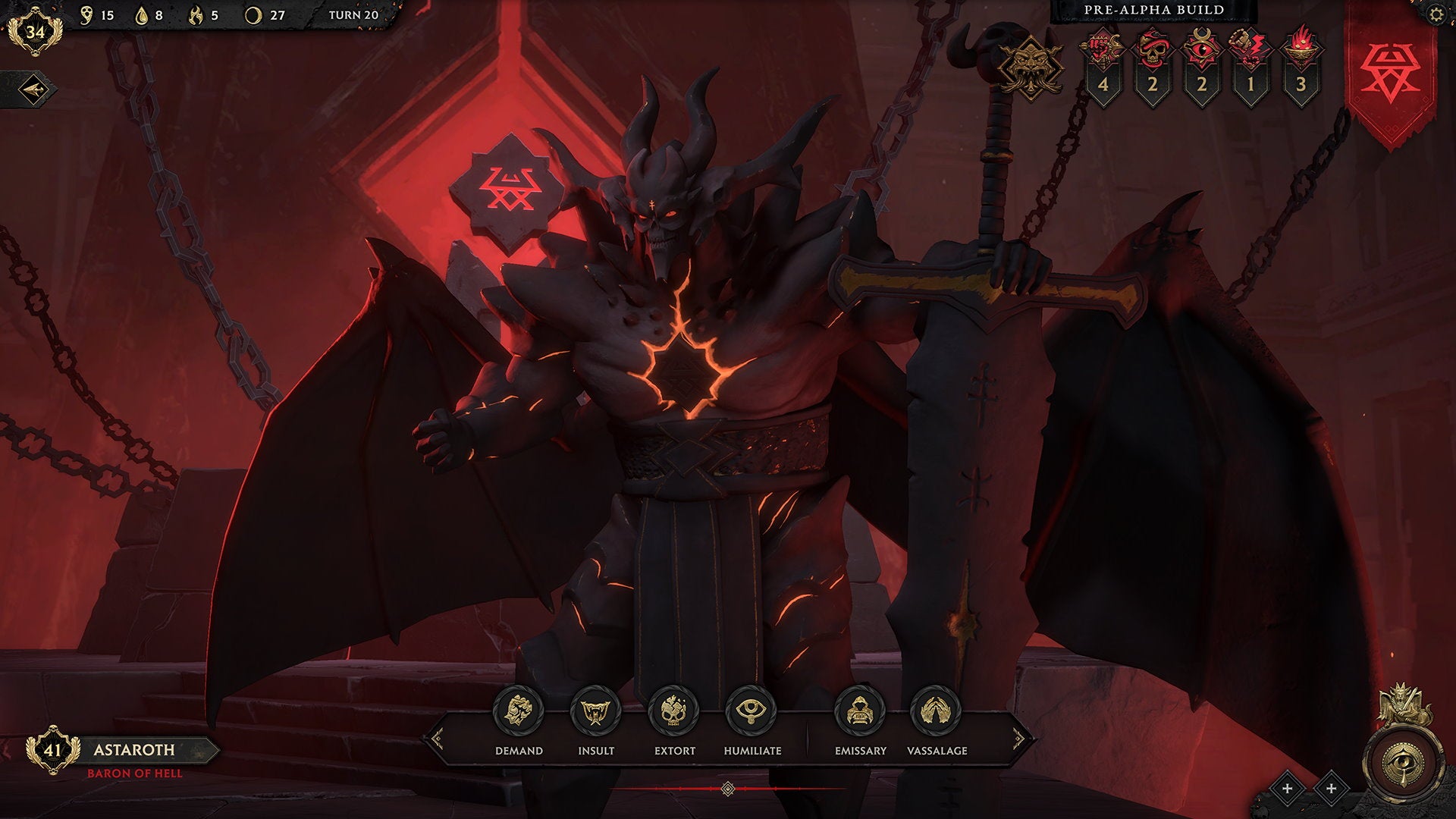
Astaroth looks set to do just that as we get into the meat of the match, but Kusters has other ideas. First, he moves Andromalius’ sole legion onto a bridge at the outskirts of Astaroth’s territory to halt his progress. These 100-strong units are represented in full in Solium Infernum, painting a much grander picture of the kinds of infernal battles you can wage. Unfortunately, Astaroth’s army minces ours in a matter of seconds, partly because he’s installed a Praetor to help lead it, a champion of Hell he’s recruited during the course of the match. These Praetors can also duel in single-combat to help settle disagreements between different Archfiends, Kusters tells me, but unfortunately I didn’t get to see any of those fights during my demo.
With our legion gone and actions spent, Kusters now turns his attention to the turn log. Turns take place simultaneously in Solium Infernum, and “this is really where so much of the game happens,” he says. “I actually can’t see what all the other Archfiends are doing during their turns, so at the end of every turn, this is where we see what’s gone down.”
“It’s a game of paranoia. You’re always trying to outsmart and outwit your opponents.”
At the top of our log, we can see we’ve obviously lost our legion, but we’ve also been targeted by a border bureaucracy ritual, and one of our hexagons has now been assigned to Belial. However, Belial himself may not be directly responsible for this action, Kusters tells me – he only appears to be, according to the turn log.
“In Solium Infernum, nothing is as it seems. You can actually mask rituals and frame [other players]. This might be Lilith framing Belial because she has a relevant level of prophecy or destruction, so it’s a game of paranoia. You’re always trying to outsmart and outwit your opponents.”
These rituals are dark spells that come in all shapes and sizes, and in order to perform them you’ll need to level up your Archfiend’s five powers: Wrath for waging war, Deceit for trickery and the ability to mislead, Prophecy for gaining hidden knowledge, Destruction to learn dark magic, and Charisma for attracting health and favour. Andromalius is currently pretty well up on the Deceit and Charisma tracks, but ranking up his Deceit to Lv.4 will earn him another ritual of his own to perform. After plugging in the necessary souls, hellfire, ichor and darkness resources to unlock it, the upgrade gets queued up in our action tray, and will come turned into playable card during the next turn.
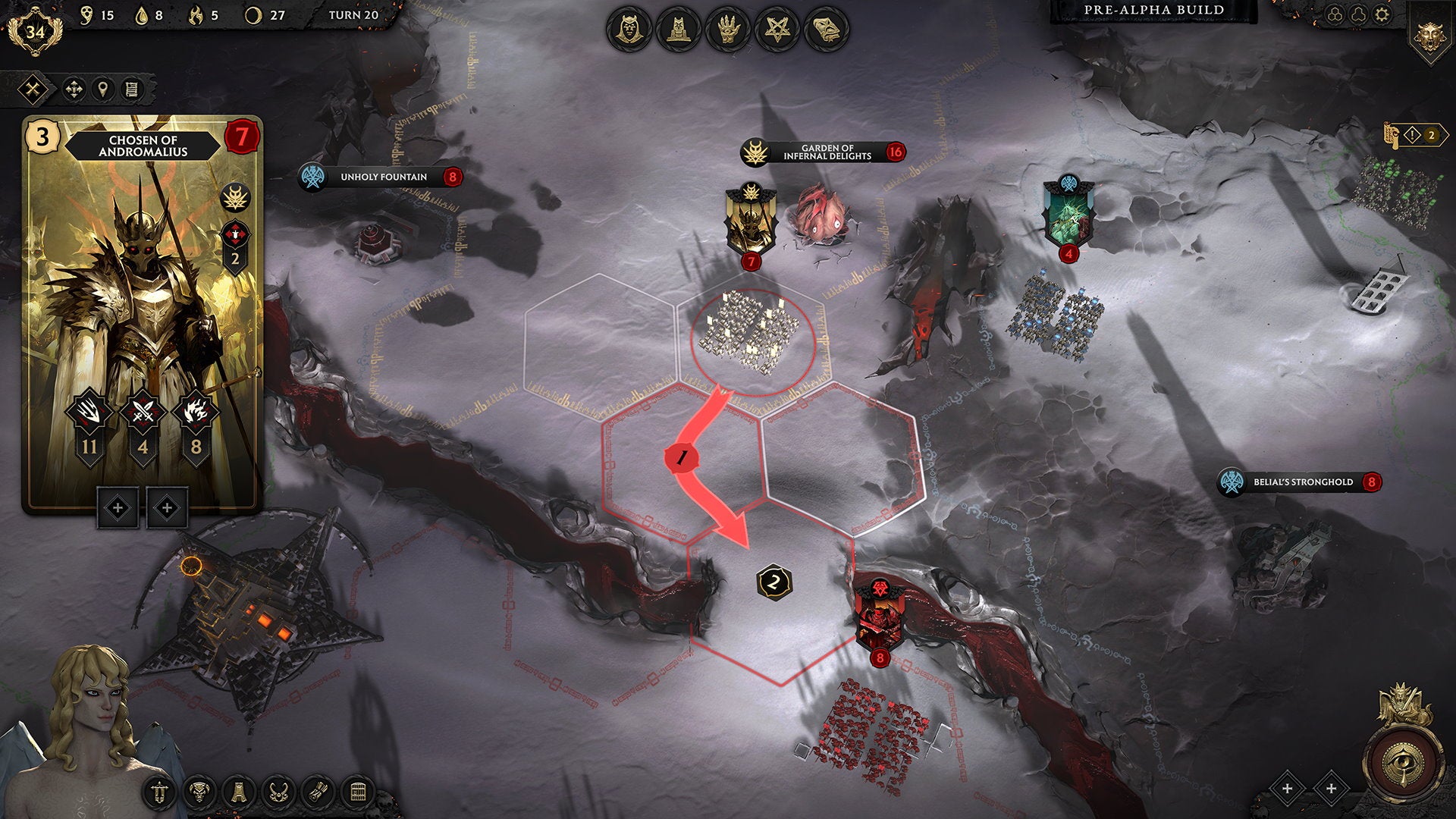
There’s still one more action we can take before that, though, and to test our theory that Lilith is currently trying to frame Belial for our border dispute, Kusters opens up Belial’s diplomacy menu to demand some resources from him. You can ask for two, three or four tribute tokens per demand, but you’ll need to wager some of your prestige in order to be successful. If Archfiends concede, you’ll get both your requested resources and your wagered prestige back, but if they reject your demand, you’ll lose that prestige, and be given the option to declare a vendetta against them in the next turn.
With our action tray now full, Kusters ends the turn and awaits the result. As various units jostle into position, the Infernal Conclave takes this moment in time to trigger a world event – an unholy crusade against Heaven’s Ramparts. We don’t have to participate in this event, but the game warns us that “those who do not offer a legion will be judged accordingly”. Presumably, by knocking our prestige tally down a few pegs. Obviously, we have no legion to offer at this point, but Kusters isn’t concerned. He dismisses it, saying we can come back to it later.
With control now back in our hands, it’s time to use that new ritual. It’s a Pilfer Artifact spell, and Kusters casts it on Lilith. Earlier in the match, you see, he used a prophecy spell to get a little glimpse of something that might be useful to Andromalius, and as he clicks Confirm, his guess was correct. Lilith has been harbouring a Devourer Statuette artifact, which is now ours for the taking.
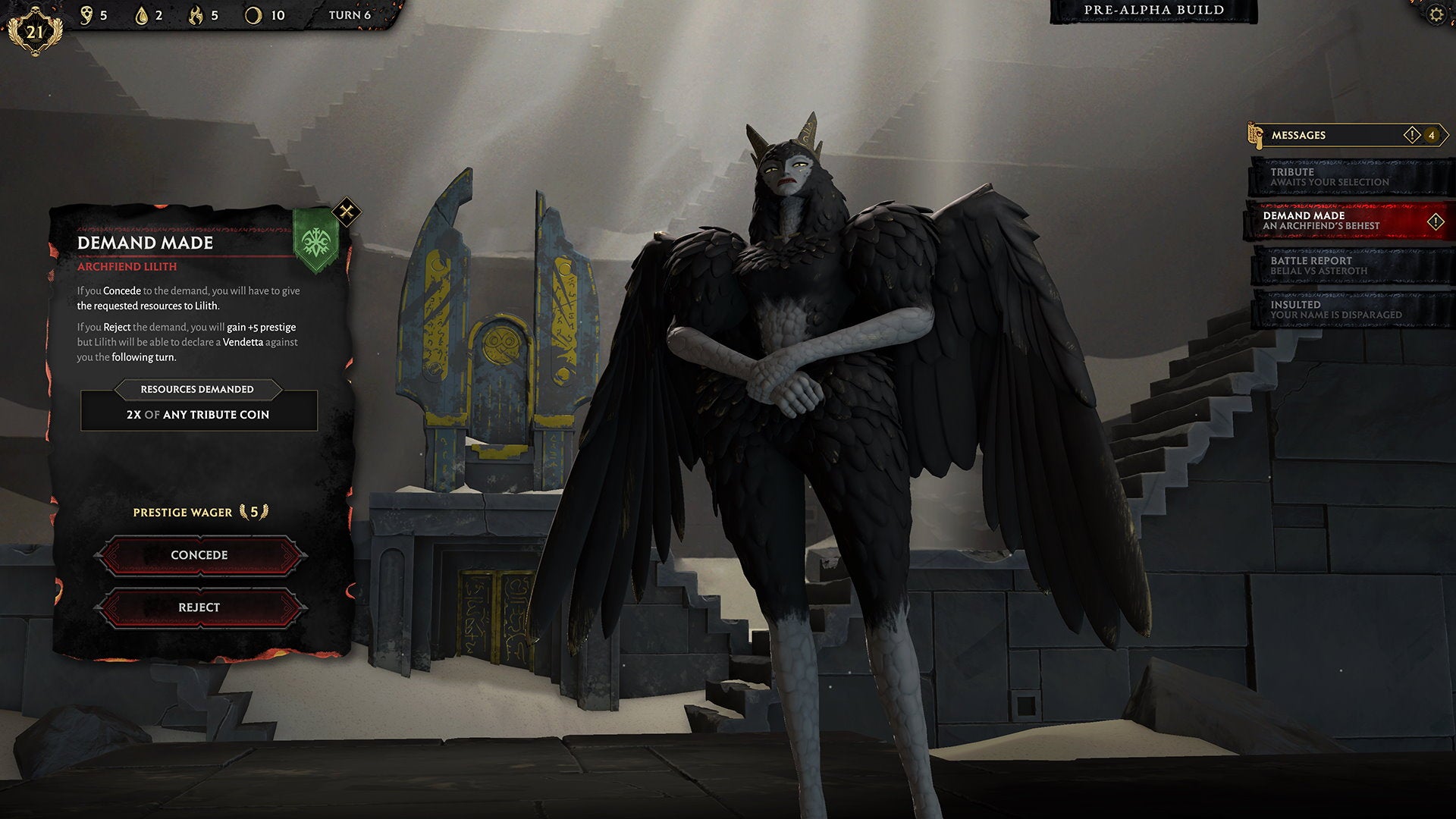
“A Devourer is a Titan,” explains Kusters. “We have our legions in the game, but what’s new to the Solium Infernum we’ve created is we’ve taken some of the most powerful and devastating legions from the last game and we’ve created these Titan units that are unique in their appearance and have this giant presence on the board – and this Devourer is the most powerful unit in the game that the player can control. By taking this artifact from Lilith, which is a magical item, I’m going to be able to install that artifact into my ritual chamber, into one of the slots, and then I’m going to get a ritual called ‘Summon Devourer’, and then when I cast that ritual, that dark magic, I’m going to summon it into the game – and I don’t think Astaroth will really be much of a threat to me after that.”
Each of these steps comes with its own associated resource cost, of course, but Kusters has prepared for this well in advance, coughing up the requisite number of souls and hellfire without taking much of a hit. Before we move to seal Astaroth’s fate, however, Lilith has taken the opportunity to insult us before the Conclave, probably because we nicked her winning trump card. Like Demands, there are two ways Insults can play out. We can either accept it and lose some prestige, or we can reject it and absorb that prestige for ourselves. However, whereas demand rejections gave you a choice of initiating a vendetta on the next turn, rejecting an insult will force you to declare a vendetta as a matter of course. As such, you’ll need to think carefully about whether it’s worth the risk. With victory pretty much within our grasp, however, Kusters accepts the insult – which Andromalius visibly rails against in the bottom left corner of the screen for some added drama.

For our final action this turn, we could probably do with a new legion – just to be on the safe side, so Kusters heads to the Infernal Bazaar, an auction house contained in another set of menu screens. Here, all Archfiends can place blind bids on different units, Praetors and artifacts. All of the legions you can bid on are from the original game, Kusters tells me, albeit with some much snazzier artwork in tow. The cards are beautiful things behold, even when they’re named things like, and I quote, “10,000 Screaming Bastards” and “Vile Apostates”. Naturally, Kusters puts a bid on the Bastards (which again, costs a bunch of resources), and ends his turn.
“At any point in time and any turn, any Archfiend could be bidding on anything in this auction house.”
“At any point in time and any turn, any Archfiend could be bidding on anything in this auction house,” he says. “We have no idea. So sometimes you’re in here bidding strategically, like, ‘Ah, I don’t want Lilith to get that artifact or something’, or you might bid higher to ensure you have that chance of getting things. But it’s been pretty quiet in here this game, so I think we’ll be okay with the minimum reserve bid on that.”
As everyone makes their moves, the turn log brings a lot of welcome news: Belial has accepted our demand, giving us two souls and two hellfire for our coffers; we won our bid on the 10,000 Screaming Bastards (huzzah); and we’re finally able to install our Devourer Statuette in our ritual circle. It will be another turn yet before our Titan appears on the board, but there’s still more we can do here to help claw some prestige back in the meantime – such as capturing another Place Of Power landmark that Belial is starting to hone in on.
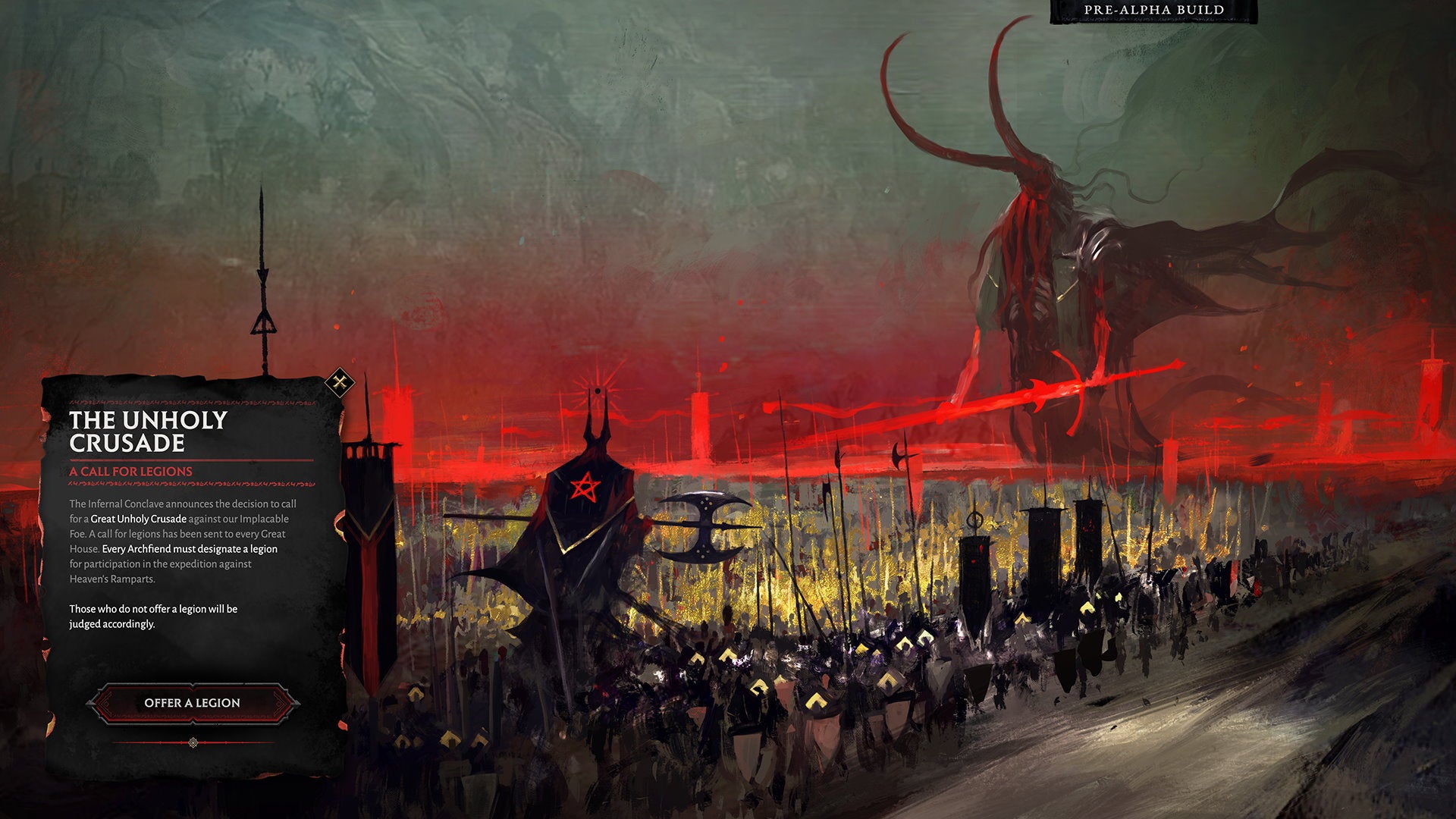
Technically, the landmark belongs to Astaroth at the moment, which makes us wonder why Belial seems to be making a play for it. Last turn, he was vendetta-free, but he’s clearly got machinations of his own underway. As turn 24 begins, Belial hurls an insult at the dragon prince to initiate his own vendetta against him, which would then allow him to enter Astaroth’s cantons and claim it on his next go. We’ve got no beef with Belial at the moment, but we also want that landmark for ourselves. Rather than initiate a full-on battle, however, Kusters simply manoeuvres his Bastards in front of the landmark, effectively cutting off Belial’s invasion route unless he starts a vendetta against us as well. It just goes to show you don’t always need to use force to get what you want.
Finally, though, it’s time to summon our Titan and reap the rewards of our scheming. As Kusters alluded to earlier, the Devourer is an enormous figure on the map, standing as tall as our stronghold as its gaping maw and rows upon rows of teeth roar loudly on the battlefield. Alas, before I get to see what happens next, the demo draws to a close. Still, the conniving machinations of these five turns have certainly whet my appetite for this reimagining of Solium Infernum, and I’m looking forward to getting to grips with it myself when it eventually comes out next year. I like the slow-paced nature of it all, and the need to think two or three turns ahead all the time reminds me of some of the best board games I played with pals in the before times. I didn’t think the brilliantly tense second-guessing of the Battlestar Galactica board game could possibly be replicated in video game form, but Solium Infernum looks set to do just that in 2023 when it releases on Steam. Here’s hoping hell doesn’t freeze over in the meantime.
